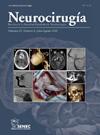Recurrent spinal subdural hematoma in granulomatosis with polyangiitis
IF 0.8
4区 医学
Q4 NEUROSCIENCES
引用次数: 0
Abstract
Nervous system involvement is uncommon in granulomatosis with polyangiitis (GPA), a systemic autoimmune disease with episodes of necrotizing vasculitis. It is usually due to the compressive effect of dural or epidural masses. Spinal hemorrhagic presentation is exceptional. A 41-year-old woman diagnosed with GPA presented with three episodes of acute spinal subdural hematoma separated by eight years and ten months, respectively. The symptomatic debut was pain and paresis in all episodes. On all occasions, a lesion compatible with acute spinal subdural hematoma was diagnosed by magnetic resonance imaging (MRI). All episodes were treated conservatively with corticosteroids and immunosuppressants. The patient presented complete neurological recovery in the first two episodes. A mild residual left lower limb paresis remains after the last one. Follow-up MRI was performed after all episodes, and no focal intraspinal lesions were detected. Spinal subdural hemorrhage is a form of manifestation of GPA, either as a debut or in the course of the disease. We describe the third confirmed case of spontaneous spinal hemorrhage secondary to GPA published in the literature and the first with recurrence. Given the extraordinary response to immunosuppressive therapy, a high level of clinical suspicion is necessary to establish treatment as early as possible.
肉芽肿合并多血管炎时复发性脊髓硬膜下血肿
肉芽肿合并多血管炎(GPA)是一种系统性自身免疫性疾病,伴坏死性血管炎发作,神经系统受累并不常见。它通常是由于硬膜或硬膜外肿块的压缩作用。脊髓出血是罕见的。一位41岁的女性被诊断为GPA,表现为三次急性脊髓硬膜下血肿发作,分别相隔8年和10个月。所有发作的症状首发是疼痛和麻痹。在所有情况下,与急性脊髓硬膜下血肿相容的病变均通过磁共振成像(MRI)诊断。所有发作均采用皮质类固醇和免疫抑制剂保守治疗。患者在前两次发作中表现出完全的神经恢复。最后一次手术后,左下肢轻度麻痹。所有发作后均行MRI随访,未发现局灶性椎管内病变。脊髓硬膜下出血是GPA的一种表现形式,无论是作为首发还是在疾病过程中。我们描述了文献中第三例确诊的自发性脊髓出血继发于GPA和第一例复发。鉴于对免疫抑制治疗的特殊反应,临床高度怀疑是必要的,以尽早确定治疗。
本文章由计算机程序翻译,如有差异,请以英文原文为准。
求助全文
约1分钟内获得全文
求助全文
来源期刊

Neurocirugia
医学-神经科学
CiteScore
1.30
自引率
0.00%
发文量
67
审稿时长
60 days
期刊介绍:
Neurocirugía is the official Journal of the Spanish Society of Neurosurgery (SENEC). It is published every 2 months (6 issues per year). Neurocirugía will consider for publication, original clinical and experimental scientific works associated with neurosurgery and other related neurological sciences.
All manuscripts are submitted for review by experts in the field (peer review) and are carried out anonymously (double blind). The Journal accepts works written in Spanish or English.
 求助内容:
求助内容: 应助结果提醒方式:
应助结果提醒方式:


